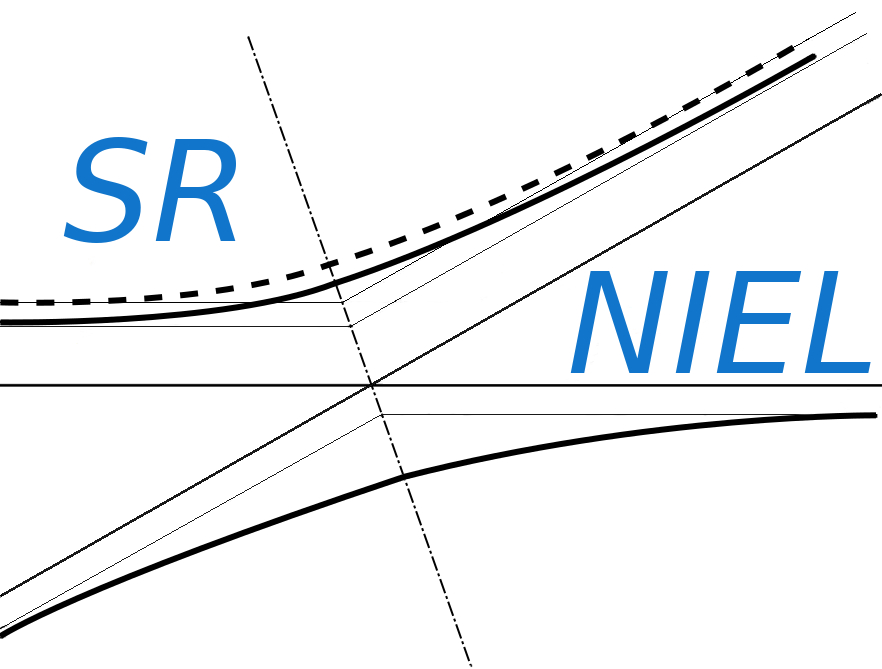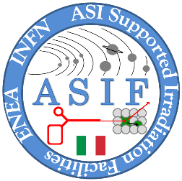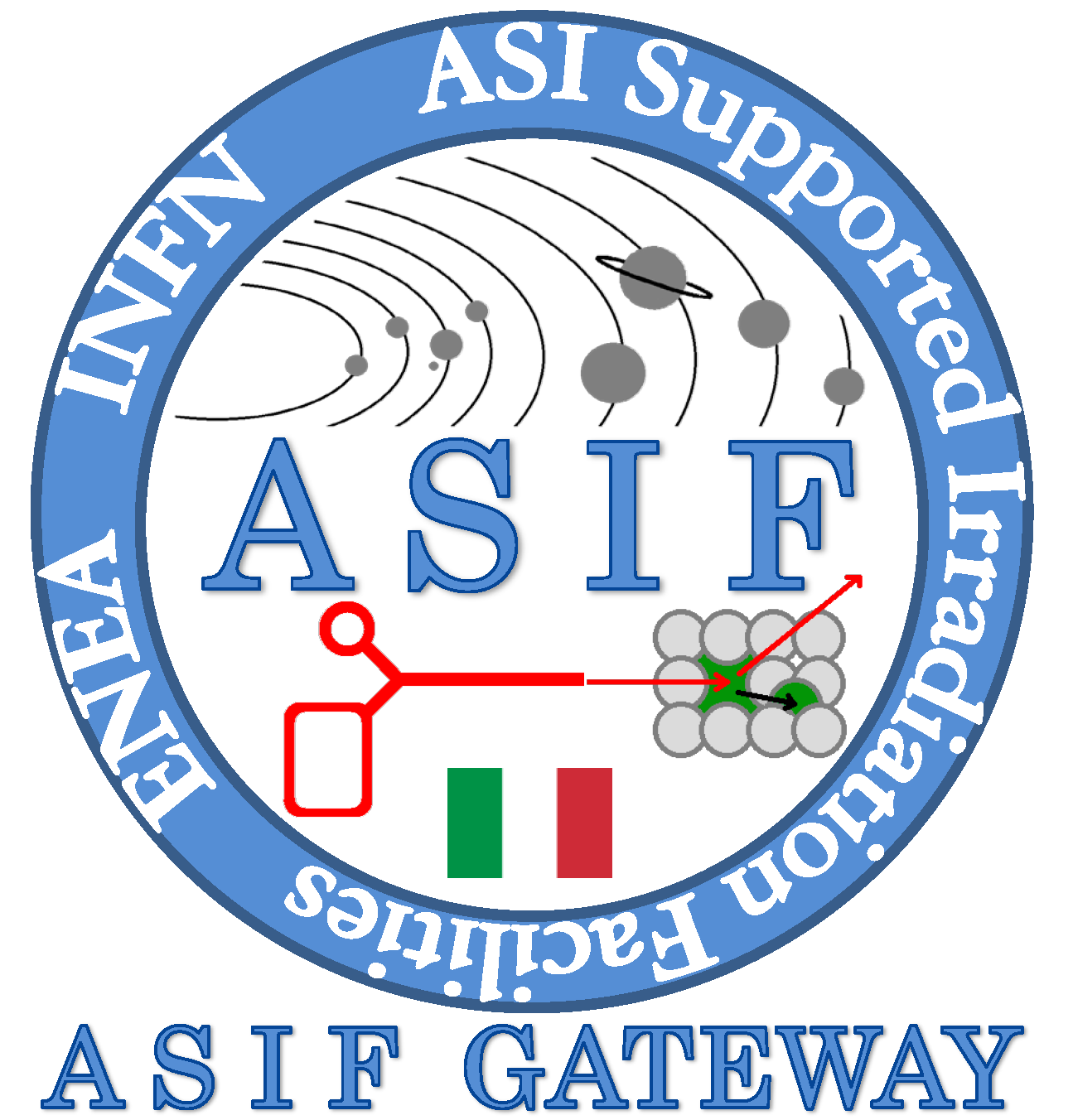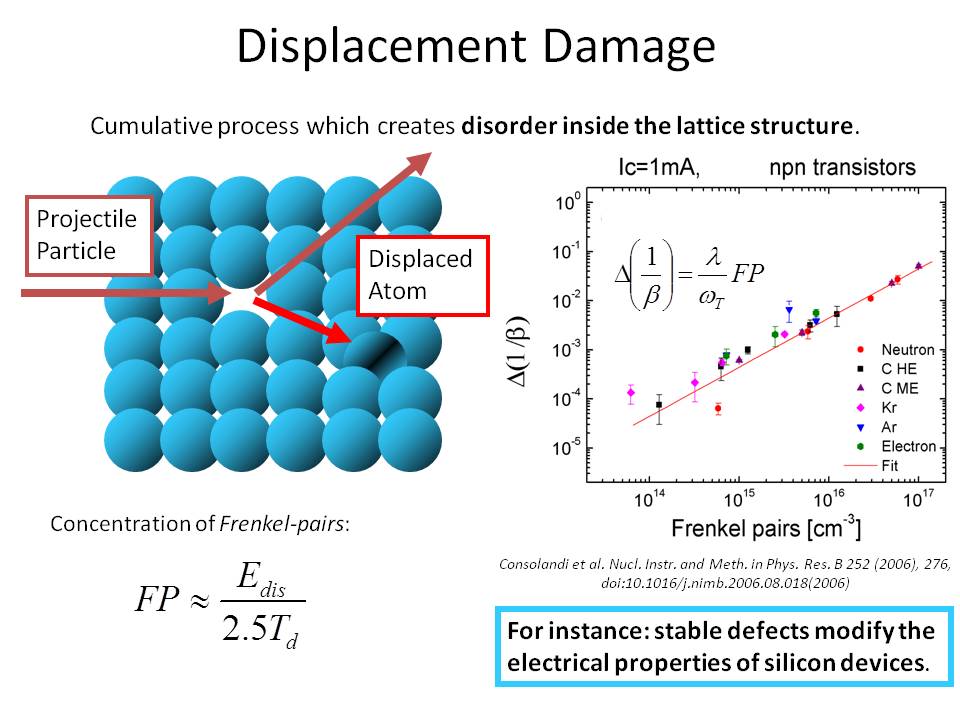General
NIEL dose and nuclear stopping power calculators for elements/compounds (e.g., semiconductors); electronic stopping powers and TID doses; SEE effects in devices; solar modulated cosmic-rays spectra at 1 AU and along mission orbits from HelMod-4 model
Website latest update on September 15, 2025
Welcome to SR-NIEL–7 Website supported within the framework of space radiation environment activities of ASIF, i.e., ASI (Italian Space Agency) Supported Irradiation Facilities. The sr-niel website was initially created in November 2014; the fundamental bibliography is provided here and at this page (see additionally SR-NIEL Framework: Physics Handbook). In these webpages, you find pieces of information about Screened Relativistic (SR) Calculators regarding Non-Ionizing Energy Loss (NIEL) of electrons, protons, ions and neutrons passing through a material and generating displacement damages which, in turn, may introduce deep levels resulting from the Frenkel pairs created. In semiconductors, these stable defects can finally degrade the device performance (for instance, they can affect the current gain of bipolar transistors). Further information on radiation damage assessment for space missions is available at ASIF website.
Moreover, calculators for the nuclear stopping powers and NIEL doses – e.g., TNIDs also termed displacement damage doses – of electrons, protons, light- and heavy-ions and for the probability of generating energetic recoil nuclei are available. These calculations are carried out based on the screened relativistic treatment for (elastic) Coulomb interactions on nuclei from low up to ultra-relativistic energies.
The notation of screened relativistic (SR) NIEL was introduced by Baur et al. (2014). Furthermore, the treatment is discussed in Sects. 2.2.1–2.2.2, 2.4.2–2.4.3, 7.1.1.6, 7.1.1.8, 11.3.1, 11.3.2 of Leroy and Rancoita (2016), e.g., see first sections of Physics Handbook on incoming massive particles and electrons.
Users should be informed that, in addition to the treatment of displacement damage mechanisms resulting from non-ionizing energy losses (NIEL), the topics included in this website were gradually extended – within the so-called SR-(NIEL) framework – to deal with the processes of electronic stopping powers, restricted energy losses, ionizing doses (TID) and effects due to large energy depositions in devices (i.e., SEE). Moreover, currently one can directly access to the solar modulated spectra for cosmic rays species with Z up to 28 from HelMod-4 model. These modulated spectra are derived by solving Parker’s equation (see here) when the local interstellar spectra (obtained from the join effort of GalProp-HelMod) are transported through the heliosphere.
From version 1.5.2, additionally, the estimates of recoil energy fractions deposited via ionizing and non-ionizing processes are accessible using two of the mostly employed analytical approximations of energy partition function. From version 2.0 the electronic stopping power and ionizing dose (TID) converter are also available.
From version 2.1 the current calculator allows one to obains NIEL values and NIEL doses (TNID) for neutrons in Si and GaAs absorbers, derived from ASTM-722-09, ASTM-722-14 and ASTM-722-19 standards.
From version 3.0 registered users can access to sr-niel web calculators with implemented the two of the mostly employed analytical approximations of energy partition function.
Currently, additional functionalities implemented into NIEL calculators available to registered users are:
- electron NIEL with Akkerman partition function;
- proton and ion NIEL with Akkerman partition function;
- NIEL dose calculators for neutrons and neutron spectral fluence in some elements (C, N, Si, Ga, As, from version 3.5.1 0, Al, P, In, Cd, Te, Ge, Zn, Se, Sb, from version 3.9 Cu, Hg, Pb, S, Sn, from version 3.9.2 B, Bi, Cl, Tl, from version 4.5.0 Li, Ti, Mn, Br, Sr, Nb, Mo, Ag, I, Ba, La, Eu, U and from version 4.6.0 also H, He, Be, F, Na, Mg, Ar, K, Ca, V, Cr, Fe, Co, Ni) and their compounds, using Robinson and Akkerman partition functions. The complete set of nuclei for neutron dose calculators was made avaible with version 5.0.0 and is illustrated at this page. From SR-NIEL–7 version 8.0, the neutron damage functions are available also using NJOY-2021 code. From version 8.5, NIEL dose calculation for neutron using Robinson and Akkerman partition functions are available obtained with NJOY-2021.
Furthermore, a critical discussion on the usage of 1 MeV neutron equivalent is also available to registered users.
In addition, the following long write-ups are available to registered users:
- NIEL for Electrons and Protons (with only Coulomb scattering and, also, including hadronic contribution) in Silicon employing Robinson and Akkerman partition functions;
- NIEL dose calculation for neutron using Robinson and Akkerman partition functions;
- comparison of Damage Functions obtained with Akkerman and Robinson Partition Functions for some compounds;
- determination of the Damage Function at 1 MeV for Si and some compounds.
More pieces of information about sr-treatment are currently available from the website section dedicated to the physics of displacement damage, due to neutron, proton, ion and electron interactions on nuclei, i.e., from the Physics Handbook.
At present, in the sr-niel website, calculators for ionizing energy losses (and doses) of electrons, protons and ions are available. From version 5.5 it is accessible a calculator to determine the residual spectral fluence for particles traversing a shielding material. From version 6.3.0, the web-calculators on electronic stopping powers – regarding the energy lost by particles traversing a medium – are complemented by those on restricted energy-losses to deal with both the energy deposited by incoming particles in absorbers and the approach to Fermi plateau at high energies.
From version 6.5.0, the occurrence probability of events due to a large energy deposition in devices - e.g., single event effects (SEE) - is additionally treated when it is induced by the electronic stopping power of incoming particles up to very hig energy; while from version 6.6.0 galactic cosmic rays fluxes are available from HelMod-4 model for being employed in sr-niel SEE calculator. From version 7.0.0, the SEE treatment is extended to deal with large energy depositions induced by Coulomb interactions on the nuclei of the absorber/target/device. Currently, the HelMod code relies on HelMod-4/CUDA, which is a GPU-accelerated method for solving the Parker Equation (e.g., see this webpage). It exploits an NVIDIA GPU farm developed under ASIF program.
From version 7.5.0, the sr-niel website is employing GEANT4 simulations to determine the equivalent SEE cross section for devices exposed to isotropically distributed particles from a Weibull function expression obtained using measurements with perpendicularly impinging particles on a device front face.
The treatment for the extension up to high energies of electronic stopping power and restricted energy loss for elements and compounds is referred to as SR-framework electronic stopping power and it is dealt in the section on Electronic stopping power up to high energy, restricted energy loss and Fermi plateau of the Physics Handbook.
Topics on electronic stopping power and restricted energy-loss are treated in the Physics Handbook which - from version 6.4.2 - is also enlarged by referring to those topics regarding activities discussed within ASIF (ASI Supported Irradiation Facilities), HelMod and GeoMagSphere websites.
Topics regarding ASIF space radiation environment and related models on solar modulation (e.g., HelMod for cosmic rays transport in the heliosphere) and particle transport in Earth magnetosphere (GeoMagSphere) are currently available in section Space Radiation Environment and Models: SR-NIEL and ASIF, HelMod, GeoMagSphere related activities. The solar modulation impact on TID doses and SEEs are discussed in the section on Effects of solar modulation on particle flux per unit area as a function of particle energy or electronic stopping power/restricted energy loss per unit length, i.e., on TID and SEE.
With version 7.5.0, the sr-niel website numbering has become SR-NIEL–7 version 7.5.
From SR-NIEL–7 version 9.5, the website was operated on a virtual server in VDC (Virtual Data Center) environment at CINECA. Currently, from version 10.14 it is operated on a virtual sever at the Italian Space Agency, ASI.
From version 10.0, additional calcolators employing GEANT4 simulations are available to determine the residual spectral fluence of isotropically distributed electrons, protons and ions traversing spherical absorbers.
From version 10.2, further additional functionalities are available to specific users involved in SR-NIEL–7 development and ASIF activities on Space Radiation Environment. Furthermore, from version 10.20, a FAQ section is available to registered users.
This project is part of the activities involving also sr-niel / HelMod /geomagsphere / ASIF /AMS-02 Milano Bicocca group.
The implementation of derived sr-niel calculators into ESA (European Space Agency) codes (e.g., SPENVIS, GRAS and Mulassis) was accomplished under ESA contract 4000116146/16/NL/HK with title "Non-Ionizing Energy Loss (NIEL) Calculation and Verification".
Following ASIF implementation agreements 2017-22-HD.0 ASI-ENEA, 2017-15-HD.0 ASI-INFN, 2021-39-HH.0 ASI-ENEA, 2021-36 HH.0 ASI-University of Milano-Bicocca and 2024-21-HH ASI-INFN, the ASIF and ASIF gateway websites, the sr-niel, helmod and geomagsphere websites are mantained within the space radiation environment activities of ASIF framework. Their websevers are handled by means of ASIF support center at the Physics Department of Milano-Bicocca University and are operated by virtual servers at the Italian Space Agency, ASI.
For any comment, remark and suggestion, please contact us by email at
Nuclear stopping power for compounds in commonly employed non-relativistic treatments
In literature, nuclear mass stopping powers for compounds were usually determined by means of Bragg's additivity rule as, for instance, those ones availabe from and tabulated for the commonly employed non-relativistic treatments of ICRUM (1993) and SRIM (e.g., see this webpage). Thus, in ICRUM (1993) and SRIM (similarly to sr-niel treatment), for a compound the overall nuclear mass stopping power in units of MeV cm2/g is obtained as a weighted sum in which each material contributes proportionally to the fraction of its atomic weight.
In the following, a few sampled compounds tabulated in ICRUM (1993) and in SRIM are dealt with regard to accuracy of calculations and systematic errors which might be induced by the very slitghly differences of atomic-weigth values (A) employed in ICRUM (1993), SRIM and SR-NIEL. For such a purpose, the tabulated non-relativistic values of nuclear stopping power of elements are obtained from ICRUM (1993) and SRIM. Then, the nuclear stopping power of sampled compounds for ICRUM (1993) and SRIMare derived by means of Bragg's additivity rule using the A-values embedded in their respective treatments. Similary, for these compounds their nuclear stopping powersa are additionally obtained by means of the A-values used in SR-NIEL database. Finally, the so obtained values for compounds are compared with the corresponding ones available and tabulated in ICRUM (1993) and SRIM.
In figures 1 and 2, respectively, it is shown the percentage difference of the calculated nuclear stopping powers for compounds (obtained employing the Bragg's additivity rule with A-values from the corresponding treatments) with respect to those tabulated in SRIM and in ICRUM (1993). In figure 3 and 4, such a percentage difference is displayed when A-values for the nuclear stopping powers of compounds are those from SR-NIEL database.
In all cases, by inspecting Figures 1-4, the difference was found to be lower than 0.1% for incoming particles with energies ranging from 1 keV up to 1 GeV.
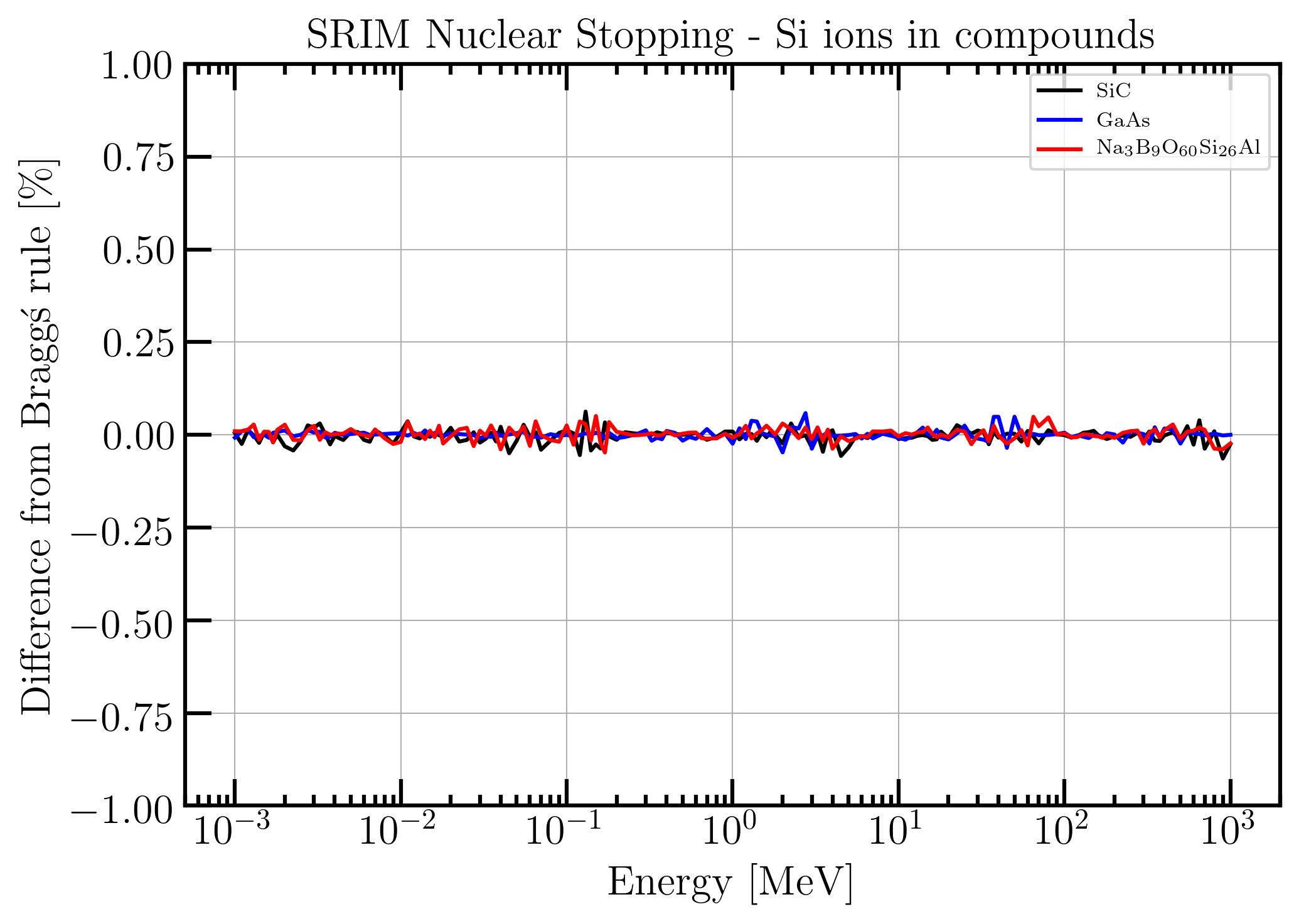 Figure 1. Percentage difference of the calculated nuclear stopping powers for Si ions in SiC, GaAs and Glass Borosilicate (obtained employing the Bragg's additivity rule with A-values from SRIM) with respect to those tabulated in SRIM.
Figure 1. Percentage difference of the calculated nuclear stopping powers for Si ions in SiC, GaAs and Glass Borosilicate (obtained employing the Bragg's additivity rule with A-values from SRIM) with respect to those tabulated in SRIM.
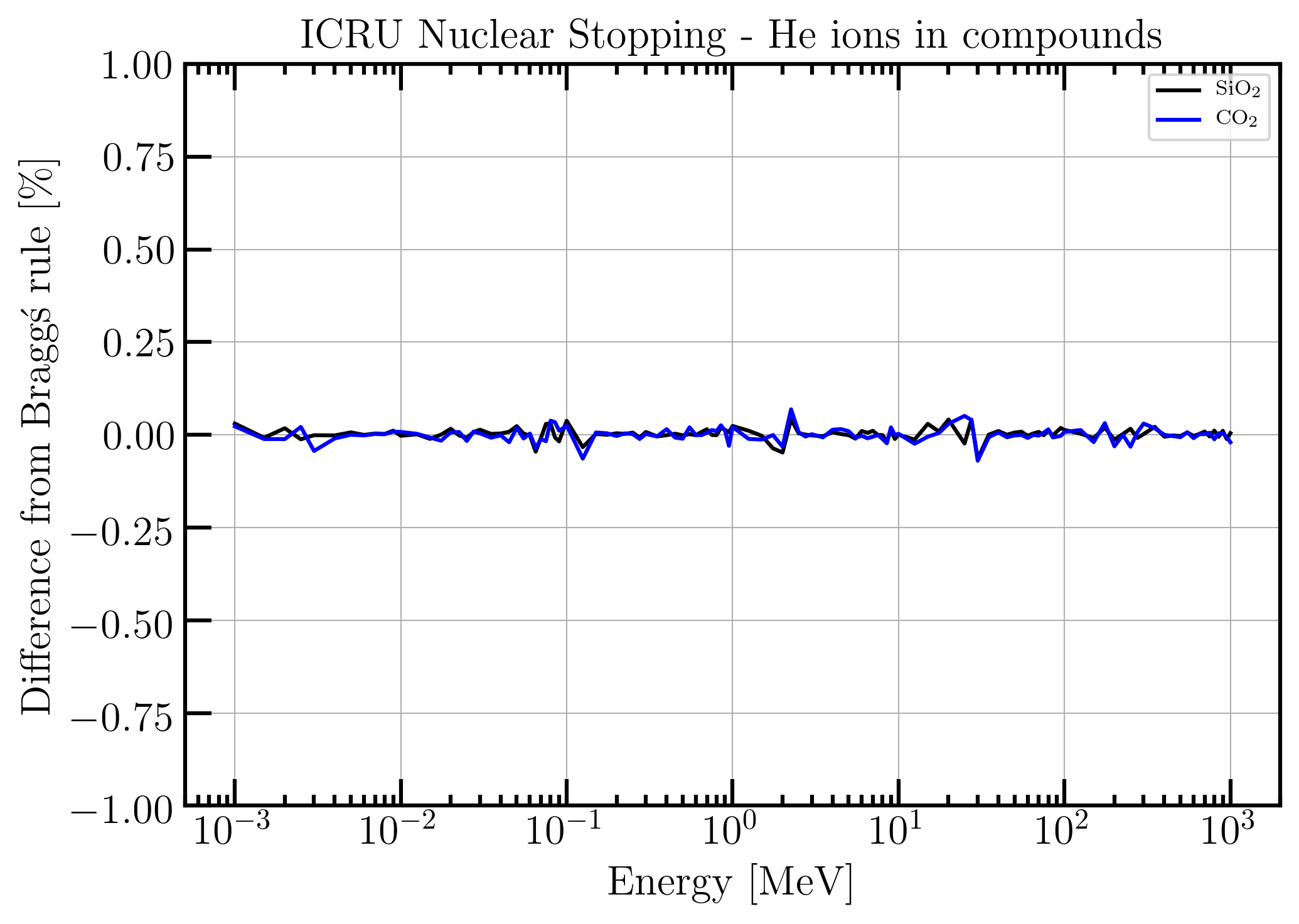 Figure 2. Percentage difference of the calculated nuclear stopping powers for Si ions in SiO2 and CO2 (obtained employing the Bragg's additivity rule with A-values from ICRUM (1993)) with respect to those tabulated in ICRUM (1993).
Figure 2. Percentage difference of the calculated nuclear stopping powers for Si ions in SiO2 and CO2 (obtained employing the Bragg's additivity rule with A-values from ICRUM (1993)) with respect to those tabulated in ICRUM (1993).
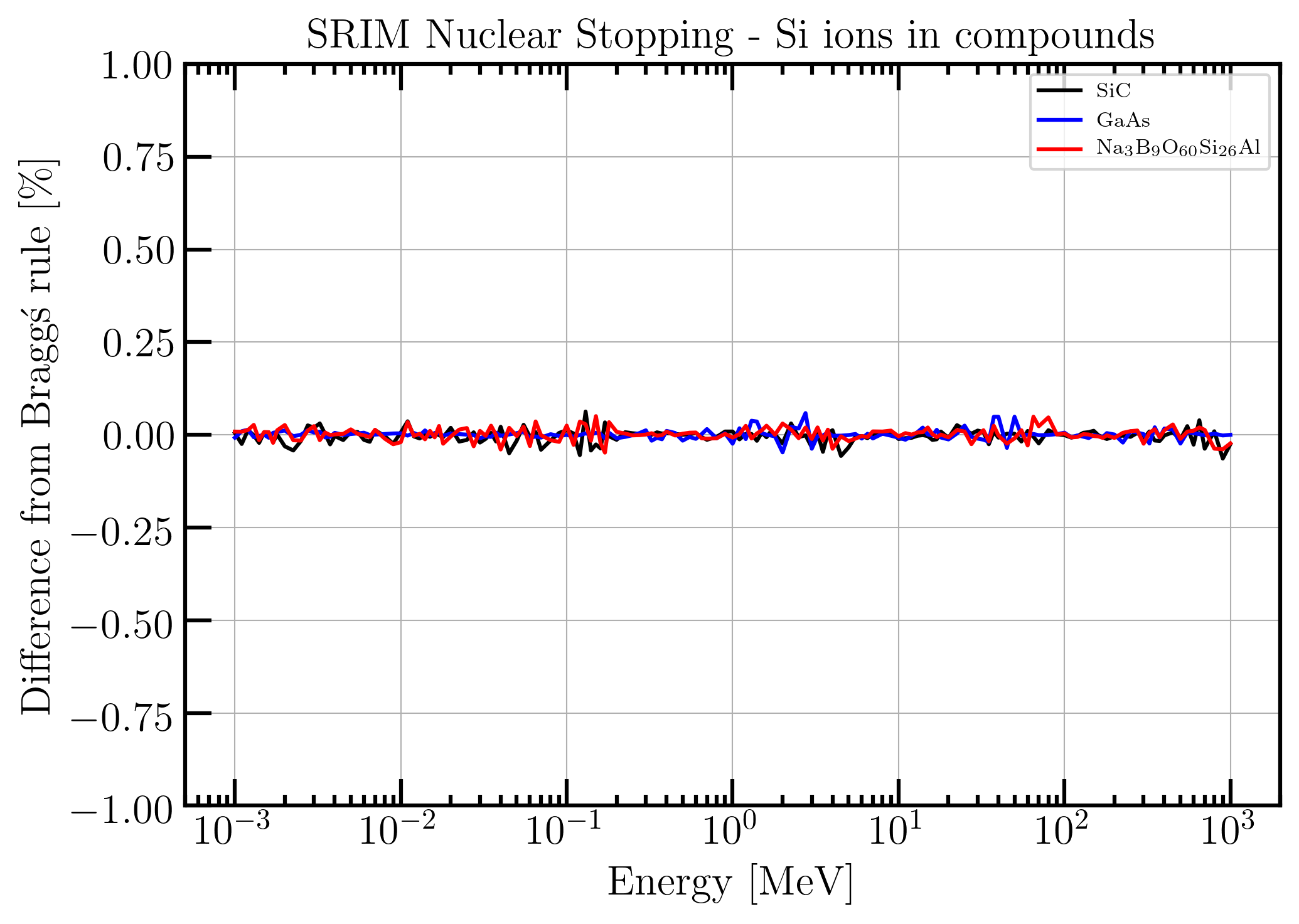
Figure 3. Percentage difference of the calculated nuclear stopping powers for Si ions in SiC, GaAs and Glass Borosilicate (obtained employing the Bragg's additivity rule with A-values from SR-NIEL database) with respect to those tabulated in SRIM.
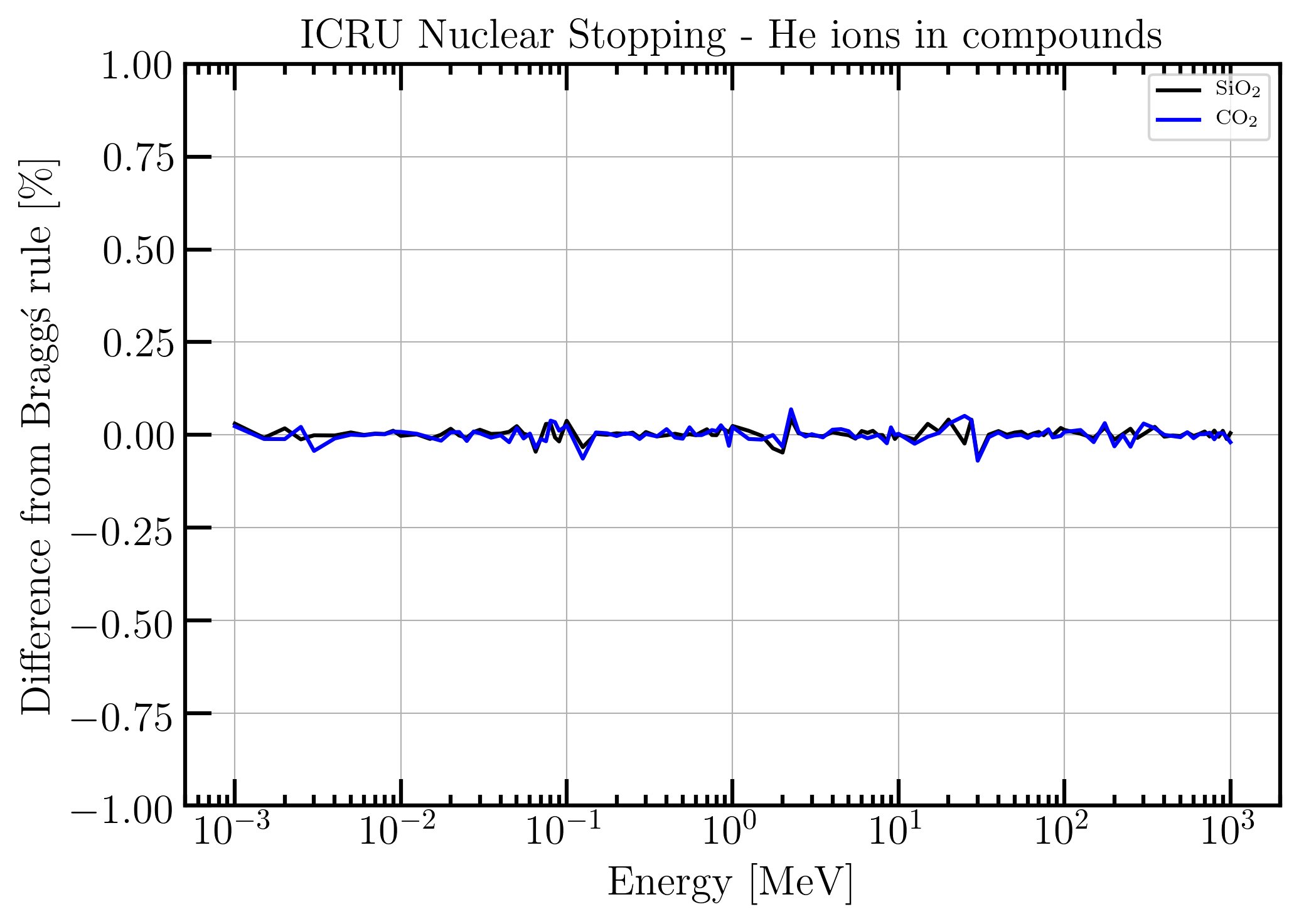 Figure 4. Percentage difference of the calculated nuclear stopping powers for Si ions in SiO2 and CO2 (obtained employing the Bragg's additivity rule with A-values from SR-NIEL database) with respect to those tabulated in ICRUM (1993).
Figure 4. Percentage difference of the calculated nuclear stopping powers for Si ions in SiO2 and CO2 (obtained employing the Bragg's additivity rule with A-values from SR-NIEL database) with respect to those tabulated in ICRUM (1993).
References
ICRUM - International Commission on Radiation Units and Measurements - (1993), Stopping Powers and Ranges for Protons and Alpha Particles, ICRU Report 49, Bethesda, MD; https://journals.sagepub.com/doi/10.1093/jicru_os25.2.iii ; webaddress: https://www.icru.org/report/stopping-power-and-ranges-for-protons-and-alpha-particles-report-49/
SRIM - The Stopping and Range of Ions in Matter - SRIM-2013
List of Compounds dealt in SR-NIEL Website for Electronic stopping power of protons and ions (from SRIM)
List of Compounds dealt in SR-NIEL Website for Electronic stopping power of protons and ions (SRIM), Electronic stopping power of protons and ions with extension to high energies for spectral fluence (SR-treatment framework), Restricted energy-loss of protons and ions with extension to high energies (SR-treatment framework)
| 1 | Air, Dry |
| 2 | Water_Liquid |
| 3 | Water_vapor |
| 4 | Concrete |
| 5 | No. 906 Graphite (carbon) |
| 6 | Glass_Pb |
| 7 | LiF |
| 8 | NaCl |
| 9 | Paraffin |
| 10 | Ilford G_5 |
| 11 | P-10 Gas |
| 12 | Methane Chloro_Trifluoro |
| 13 | Anthracene |
| 14 | CsI |
| 15 | PilotB |
| 16 | KI |
| 17 | NaI |
| 18 | Stilbene |
| 19 | Toluene |
| 20 | GaAs |
| 21 | Glass Soda_Lime |
| 22 | Glass Boro_Silicate |
| 23 | Pyrex |
| 24 | Pyrex_Pb |
| 25 | PMMA |
| 26 | AZ_111 |
| 27 | Photoresist_Siemens |
| 28 | Si3N4 |
| 29 | SiO2 |
| 30 | YBaCuO |
| 31 | HiTc TlCaBaCu_2223 |
| 32 | HiTc BiSrCaCuO_2212 |
| 33 | Water |
| 34 | Air, Dry |
| 35 | Water_Liquid |
| 36 | Water_vapor |
| 37 | Concrete |
| 38 | Al2O3 |
| 39 | Bakelite |
| 40 | Delrin |
| 41 | Lexan |
| 42 | Lucite |
| 43 | Mylar |
| 44 | Nylon_6 and 6_6 |
| 45 | Paraffin |
| 46 | Plexiglas |
| 47 | Teflon |
| 48 | Bakelite |
| 49 | Epoxy (cast) |
| 50 | Epoxy (molded) |
| 51 | No. 760 Formvar |
| 52 | Lexan |
| 53 | Paralene_C |
| 54 | Paralene_N |
| 55 | Plexiglas |
| 56 | Polyethylene |
| 57 | Mylar |
| 58 | Lucite |
| 59 | PMMA |
| 60 | Polypropylene |
| 61 | Polyimid |
| 62 | Polystyrene |
| 63 | PVC |
| 64 | Saran |
| 65 | BeCu |
| 66 | Brass |
| 67 | Bronze |
| 68 | Inconel_600 |
| 69 | Monel_400 |
| 70 | Stainless Steel |
| 71 | ICRU-099 A-150 Tissue Equiv. Plastic |
| 72 | ICRU-101 Acetylene |
| 73 | ICRU-103 Adipose Tissue (ICRP) |
| 74 | ICRU-104 Air, Dry |
| 75 | ICRU-106 Aluminum Oxide |
| 76 | ICRU-111 B-00 Bone-Equivalent Plastic |
| 77 | ICRU-119 Bone Compact (ICRU) |
| 78 | ICRU-120 Bone Compact (ICRP) |
| 79 | ICRU-126 C-552 Air Equivalent Plastic |
| 80 | ICRU-130 Calcium Fluoride |
| 81 | ICRU-134 Carbon Dioxide |
| 82 | ICRU-138 Cellulose Nitrate |
| 83 | ICRU-139 Ceric Sulfate Dosimeter Sol. |
| 84 | ICRU-141 Cesium Iodide |
| 85 | ICRU-155 Ethylene |
| 86 | ICRU-160 Ferrous Sulfate Dosimeter Sol. |
| 87 | ICRU-169 Glass BoroSilicate (Pyrex) |
| 88 | ICRU-179 Kapton Polyimide Film |
| 89 | ICRU-185 Lithium Fluoride |
| 90 | ICRU-189 Lithium TetraBorate |
| 91 | ICRU-191 M-3 Wax |
| 92 | ICRU-197 Methane |
| 93 | ICRU-200 Tissue Substitute |
| 94 | ICRU-201 Muscle Skeletal(ICRP) |
| 95 | ICRU-202 Muscle Striated (ICRU) |
| 96 | ICRU-203 Muscle Equiv. Liq. w/Sucrose |
| 97 | ICRU-204 Muscle Equiv. Liq. wo/Sucrose |
| 98 | ICRU-209 Mylon Type 6 and Type 6/6 |
| 99 | ICRU-213 Paraffin Wax |
| 100 | ICRU-215 Photographic Emulsion |
| 101 | ICRU-216 Plastic Scintillator (Vinyltoluene based) |
| 102 | ICRU-219 Polycarbonate (LexanMakrofol) |
| 103 | ICRU-221 Polyethylene |
| 104 | ICRU-222 Mylar (Polyethylene Terephthalate |
| 105 | ICRU-223 Polymethly Methacralate (Lucite Persplex) |
| 106 | ICRU-225 Polypropylene |
| 107 | ICRU-226 Polystyrene |
| 108 | ICRU-227 Teflon (PolyetraFluoroEthylene) |
| 109 | ICRU-232 PVC (Polyvinylchloride) |
| 110 | ICRU-238 Propane |
| 111 | ICRU-245 SiO2 |
| 112 | ICRU-252 NaI (Sodium Iodide) |
| 113 | ICRU-255 Stilbene |
| 114 | ICRU-263 Tissue-Eq. Gas (Methane Based) |
| 115 | ICRU-264 Tissue-Eq. Gas (Propane Based) |
| 116 | ICRU-266 Toluene |
| 117 | No. 267 Toluene |
| 118 | ICRU-276 Water_Liquid |
| 119 | ICRU-277 Water_vapor |
| 120 | No. 300 Acetaldehyde |
| 121 | No. 301 Acetone |
| 122 | No. 314 Anthracene |
| 123 | No. 320 Barium Chloride |
| 124 | No. 322 Barium Fluoride |
| 125 | No. 342 Butene |
| 126 | No. 344 Butyne |
| 127 | No. 346 Cadmium Telluride |
| 128 | No. 348 Carbon disulfide |
| 129 | No. 350 Carbon Monoxide |
| 130 | No. 380 Chloroform |
| 131 | No. 390 CR-39 (PADC) |
| 132 | No. 392 Cycloheptane |
| 133 | No. 394 1_3 Cyclohexadiene |
| 134 | No. 400 Cyclohexane |
| 135 | No. 414 Dichloromethane |
| 136 | No. 420 Dimethylsulfite |
| 137 | No. 422 Erbium oxide |
| 138 | No. 426 Ethyl bromide |
| 139 | No. 428 Ethyl cellulose |
| 140 | No. 430 Ethyl iodide |
| 141 | No. 431 Ethylamine |
| 142 | No. 432 Ethylene Oxide |
| 143 | No. 434 Ethylene Sulfide |
| 144 | No. 436 Ethynylbenzene |
| 145 | No. 438 Freon-114-B2 |
| 146 | No. 441 Freon-116 |
| 147 | No. 444 Freon-12 |
| 148 | No. 448 Freon-13 |
| 149 | No. 452 Freon-13B1 |
| 150 | No. 455 Freon-C-318 |
| 151 | No. 458 Gallium antimonide |
| 152 | No. 460 Gallium arsenide |
| 153 | No. 462 Gallium Nitride |
| 154 | No. 465 Gallium phosphide |
| 155 | No. 468 Genetron-21 |
| 156 | No. 469 Glycerol |
| 157 | No. 470 Havar |
| 158 | No. 471 Heptane |
| 159 | No. 473 Heptyne |
| 160 | No. 474 Hexane |
| 161 | No. 478 Hexene |
| 162 | No. 482 Hexyne |
| 163 | No. 490 Indium oxide |
| 164 | No. 492 Indium phosphide |
| 165 | No. 494 Isooctane |
| 166 | No. 500 Lithium niobate |
| 167 | No. 502 Decene |
| 168 | No. 503 Heptene |
| 169 | No. 504 Octene |
| 170 | No. 510 LR-115 Nuclear track detector |
| 171 | No. 512 Methylamine |
| 172 | No. 514 Mu metal |
| 173 | No. 522 Nonane |
| 174 | No. 524 Octane |
| 175 | No. 527 Pentadecane |
| 176 | No. 533 Pentyne |
| 177 | No. 535 Perfluoropropane |
| 178 | No. 540 Permalloy 4750 |
| 179 | No. 550 Pliolite S-5A |
| 180 | No. 564 Polysulfone |
| 181 | No. 570 Polyvinyltoluene |
| 182 | No. 572 Potassium titanyl arsenate |
| 183 | No. 576 Propyne |
| 184 | No. 580 Scandium oxide |
| 185 | No. 590 Silicon Carbide |
| 186 | No. 594 Silver gallium disulfide |
| 187 | No. 594 Silver gallium disulfide |
| 188 | No. 610 Sulfur dioxide |
| 189 | No. 620 Tantalum pentoxide |
| 190 | No. 630 Terphenyl |
| 191 | No. 632 Tetradecane |
| 192 | No. 650 Titanium nitrogen oxide |
| 193 | No. 652 Titanium oxide |
| 194 | No. 656 Trimethylamine |
| 195 | No. 659 Tridecane |
| 196 | No. 660 Tungsten trioxide |
| 197 | No. 662 Undecane |
| 198 | No. 670 Uranium oxide |
| 199 | No. 680 Vinyl bromide |
| 200 | No. 690 Vyns |
| 201 | No. 700 Zinc selenide |
| 202 | No. 704 Zinc silicon diphosphide |
| 203 | No. 710 Zinc telluride |
| 204 | No. 740 14-Dioxane |
| 205 | No. 748 Dimethyl amine |
| 206 | No. 750 Dimethyl disulfide |
| 207 | No. 754 Dimethyl sulfide |
| 208 | No. 756 Dodecane |
| 209 | No. 765 Alcohol_Isopropyl |
| 210 | No. 767 Alcohol_Butyl |
| 211 | No. 769 Alcohol_Amyl |
| 212 | No. 771 Hexanol |
| 213 | No. 773 Alcohol_Heptyl |
| 214 | No. 775 Octanol |
| 215 | No. 777 Alcohol_Nonyl |
| 216 | No. 779 Decanol |
| 217 | No. 781 Undecanol |
| 218 | Skin_Human (W&W type 1) |
| 219 | Skin_Human (W&W type 2) |
| 220 | Skin_Human (W&W type 3) |
| 221 | Skeletal Muscle (W&W Type 1) |
| 222 | Skeletal Muscle (W&W type 2) |
| 223 | Skeletal Muscle (W&W Type 3) |
| 224 | Skeleton_Cartilage (W&W) |
| 225 | Skeleton_Spongiosa (W&W) |
| 226 | Skeleton_Red Marrow (W&W) |
| 227 | Skeleton_Yellow Marrow (W&W) |
| 228 | Cortical Bone Adult (W&W) |
| 229 | Cortical Bone Ages 6_13 (W&W) |
| 230 | Cortical Bone Ages 2_5 (W&W) |
| 231 | Perinatal Rhesus Monkey (W&W) 1.40 |
| 232 | Mammary Gland (W&W Type 1) |
| 233 | Mammary Gland (W&W Type 2) |
| 234 | Mammary Gland (W&W Type 3) |
| 235 | Spleen (W&W) |
| 236 | Testis (W&W) |
| 237 | Thyroid (W&W) |
| 238 | Trachea (W&W) |
| 239 | Ovary (W&W) |
| 240 | Pancreas (W&W) |
| 241 | Prostate (W&W) |
| 242 | Urinary Bladder_Urine (W&W) |
| 243 | Urinary Bladder_Empty (W&W) |
| 244 | Urinary Bladder_Filled (W&W) |
| 245 | A-150 Tissue-Eqiv. Plastic (ICRU) |
| 246 | Adipose Tissue (ICRP) |
| 247 | B_100 Bone Eqiv. Plastic (ICRU) |
| 248 | Bone Compact (ICRU) |
| 249 | Bone Compact (ICRP) |
| 250 | MS_20 Tissue Substitute (ICRU) |
| 251 | Muscle Skeletal (ICRP) |
| 252 | Muscle Striated (ICRU) |
| 253 | Muscle_Eqiv.Liquid w_sucrose (ICRU) |
| 254 | Muscle_Eqiv.Liquid wo_sucrose (ICRU) |
| 255 | No. 300 Acetaldehyde |
| 256 | AceticAcid |
| 257 | No. 301 Acetone |
| 258 | Acetylene |
| 259 | No. 305 Alcohol-Methyl |
| 260 | No. 303 Alcohol_Ethyl |
| 261 | No. 307 Alcohol_Propyl |
| 262 | Alcohol_Undecanol |
| 263 | No. 309 Allene |
| 264 | No. 310 Ammonia |
| 265 | Aniline |
| 266 | No. 329 Benzene |
| 267 | Bicylo 2_2_1 |
| 268 | No. 340 Butane |
| 269 | No. 334 1_3 Butadiene |
| 270 | No. 716 2_Butanone |
| 271 | No. 718 Butyraldehyde |
| 272 | Carbon Dioxide |
| 273 | No. 360 Carbon Tetrachloride |
| 274 | No. 370 Carbon Tetrafluoride |
| 275 | 1_Chlorobutane |
| 276 | 1_Chloro Hexadecane |
| 277 | 1_Chloro Hexane |
| 278 | 2_Chloro_2_Methylpropane |
| 279 | 1_Chloro Propane |
| 280 | Cyclobutane |
| 281 | 1_3_5 CycloHeptatriene |
| 282 | No. 394 1_3 Cyclohexadiene |
| 283 | No. 400 Cyclohexane |
| 284 | No. 728 Cyclohexanone |
| 285 | No. 729 Cyclohexene |
| 286 | No. 731 Cyclooctane |
| 287 | Cyclooctene |
| 288 | No. 403 Cyclopentane |
| 289 | No. 405 Cyclopentene |
| 290 | No. 410 Cyclopropane |
| 291 | Cyclopropene |
| 292 | No. 411 n_Decane |
| 293 | 1 Decene |
| 294 | 1_2 Dichloroethane |
| 295 | No. 418 1_2 Difluoroethane |
| 296 | No. 417 1_2 Difluoroethene |
| 297 | p_Dioxane |
| 298 | No. 424 Ethane |
| 299 | 1_2 Ethanediol |
| 300 | Ethane Hexafluoride |
| 301 | No. 752 Ether Dimethyl |
| 302 | No. 684 Ether Vinyl_Methyl |
| 303 | No. 735 Ether Diethyl |
| 304 | Ethylene |
| 305 | No. 432 Ethylene Oxide |
| 306 | No. 434 Ethylene Sulfide |
| 307 | FormicAcid |
| 308 | Formaldehyde |
| 309 | Glycerol |
| 310 | No. 485 Hydrogen Sulfide |
| 311 | Methyl Sulfide |
| 312 | Methane |
| 313 | Methane Chloro_Trifluoro |
| 314 | Methane Dichloro_Difluoro |
| 315 | Methane Dichloro_Fluoro |
| 316 | 2 Methy l_1_3 Butadiene |
| 317 | No. 520 Nitric Oxide |
| 318 | No. 521 Nitrous Oxide |
| 319 | Octanoic Acid |
| 320 | No. 528 n_Pentane |
| 321 | n_Pentadecane |
| 322 | 1_5 Pentanediol |
| 323 | No. 742 3-Pentanone |
| 324 | No. 532 1_Pentene |
| 325 | Phenylacetylene |
| 326 | Propane |
| 327 | 1_3 Propanediol |
| 328 | 2_Propanol |
| 329 | Propylamine |
| 330 | No. 574 Propylene |
| 331 | No. 800 Propylene Oxide |
| 332 | No. 802 Propylene Sulfide |
| 333 | No. 614 Sulfur Hexafluoride |
| 334 | No. 600 Styrene |
| 335 | No. 640 Thiophene |
| 336 | Toluene |
| 337 | No. 658 Trimethylene Sulfide |
| 338 | Xylene |
| 339 | Water_Liquid |
| 340 | Water_vapor |
| 341 | Hydrogen |
| 342 | Helium |
| 343 | Carbon |
| 344 | Nitrogen |
| 345 | Oxygen |
